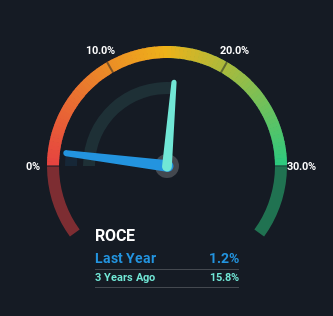- China
- /
- Electronic Equipment and Components
- /
- SZSE:300814
The Returns On Capital At Shenzhen Jove Enterprise (SZSE:300814) Don't Inspire Confidence
Did you know there are some financial metrics that can provide clues of a potential multi-bagger? One common approach is to try and find a company with returns on capital employed (ROCE) that are increasing, in conjunction with a growing amount of capital employed. This shows us that it's a compounding machine, able to continually reinvest its earnings back into the business and generate higher returns. However, after briefly looking over the numbers, we don't think Shenzhen Jove Enterprise (SZSE:300814) has the makings of a multi-bagger going forward, but let's have a look at why that may be.
Return On Capital Employed (ROCE): What Is It?
For those that aren't sure what ROCE is, it measures the amount of pre-tax profits a company can generate from the capital employed in its business. Analysts use this formula to calculate it for Shenzhen Jove Enterprise:
Return on Capital Employed = Earnings Before Interest and Tax (EBIT) ÷ (Total Assets - Current Liabilities)
0.012 = CN¥21m ÷ (CN¥2.4b - CN¥727m) (Based on the trailing twelve months to June 2024).
So, Shenzhen Jove Enterprise has an ROCE of 1.2%. Ultimately, that's a low return and it under-performs the Electronic industry average of 5.4%.
View our latest analysis for Shenzhen Jove Enterprise

Historical performance is a great place to start when researching a stock so above you can see the gauge for Shenzhen Jove Enterprise's ROCE against it's prior returns. If you want to delve into the historical earnings , check out these free graphs detailing revenue and cash flow performance of Shenzhen Jove Enterprise.
So How Is Shenzhen Jove Enterprise's ROCE Trending?
In terms of Shenzhen Jove Enterprise's historical ROCE movements, the trend isn't fantastic. Over the last five years, returns on capital have decreased to 1.2% from 19% five years ago. And considering revenue has dropped while employing more capital, we'd be cautious. This could mean that the business is losing its competitive advantage or market share, because while more money is being put into ventures, it's actually producing a lower return - "less bang for their buck" per se.
On a side note, Shenzhen Jove Enterprise has done well to pay down its current liabilities to 30% of total assets. That could partly explain why the ROCE has dropped. Effectively this means their suppliers or short-term creditors are funding less of the business, which reduces some elements of risk. Some would claim this reduces the business' efficiency at generating ROCE since it is now funding more of the operations with its own money.
What We Can Learn From Shenzhen Jove Enterprise's ROCE
In summary, we're somewhat concerned by Shenzhen Jove Enterprise's diminishing returns on increasing amounts of capital. Despite the concerning underlying trends, the stock has actually gained 9.9% over the last three years, so it might be that the investors are expecting the trends to reverse. Regardless, we don't like the trends as they are and if they persist, we think you might find better investments elsewhere.
Shenzhen Jove Enterprise does have some risks, we noticed 3 warning signs (and 1 which is a bit concerning) we think you should know about.
While Shenzhen Jove Enterprise isn't earning the highest return, check out this free list of companies that are earning high returns on equity with solid balance sheets.
New: Manage All Your Stock Portfolios in One Place
We've created the ultimate portfolio companion for stock investors, and it's free.
• Connect an unlimited number of Portfolios and see your total in one currency
• Be alerted to new Warning Signs or Risks via email or mobile
• Track the Fair Value of your stocks
Have feedback on this article? Concerned about the content? Get in touch with us directly. Alternatively, email editorial-team (at) simplywallst.com.
This article by Simply Wall St is general in nature. We provide commentary based on historical data and analyst forecasts only using an unbiased methodology and our articles are not intended to be financial advice. It does not constitute a recommendation to buy or sell any stock, and does not take account of your objectives, or your financial situation. We aim to bring you long-term focused analysis driven by fundamental data. Note that our analysis may not factor in the latest price-sensitive company announcements or qualitative material. Simply Wall St has no position in any stocks mentioned.
About SZSE:300814
Shenzhen Jove Enterprise
Engages in the research and development, production, and sales of printed circuit boards (PCB) in China and internationally.
Adequate balance sheet with acceptable track record.
Market Insights
Community Narratives



